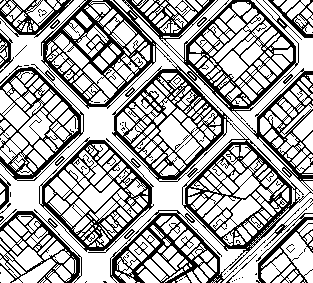
The 15-minute City
Organic and Planned Processes of Development

Hari Srinivas Concept Note Series C-043
Abstract:
This concept note explores the idea of the 15-minute city through the lens of organic and planned urban development processes. Organic 15-minute cities, such as Paris, Tokyo, Amsterdam, and Marrakech, have evolved naturally over time, shaped by historical, cultural, and spatial dynamics that support proximity to daily amenities.In contrast, planned 15-minute cities like Vauban, Nantes, Melbourne, and Vancouver are the result of deliberate urban planning strategies aimed at achieving walkability, mixed land use, and accessibility. The document compares these two approaches to highlight how both models contribute to sustainable, inclusive, and livable urban environments.
Keywords:
15-minute city, Urban planning, Organic development, Walkability, Mixed-use neighborhoods, Sustainable cities, Accessibility, Urban livability

Organic 15-Minute Cities
Organic 15-minute cities refer to urban areas that have naturally evolved over time without deliberate planning or design interventions to achieve the 15-minute city concept. These cities typically developed organically, often influenced by historical factors, cultural patterns, and the natural growth of communities.
In an organic 15-minute city, the proximity of essential amenities, services, and recreational spaces is often a result of historical settlement patterns and the natural evolution of urban infrastructure. Over time, as neighborhoods grow and develop, they tend to organically shape their built environment to accommodate a variety of needs within a short distance. This can include a mix of residential, commercial, and recreational spaces that are conveniently accessible by foot, bicycle, or public transportation.
1. Paris, France: Paris is often cited as an example of an organic 15-minute city due to its historical development. The city's compact layout, mixed-use neighborhoods, and extensive public transportation system contribute to its walkability and accessibility. Essential amenities such as grocery stores, schools, parks, and cultural attractions are generally within a short distance, allowing residents to fulfill their daily needs easily.
2. Tokyo, Japan: Tokyo is another example of an organic 15-minute city. The city's dense urban fabric and efficient public transportation system, including an extensive subway network, contribute to its accessibility and convenience. Residents can find a wide range of amenities, from shops and markets to healthcare facilities and parks, within walking or cycling distance from their homes.
3. Amsterdam, Netherlands: Amsterdam is known for its organic development and compact urban layout, making it conducive to a 15-minute city concept. The city's historic center is characterized by mixed-use neighborhoods where residents have easy access to daily necessities, such as grocery stores, schools, parks, and cultural attractions. The extensive cycling infrastructure further enhances accessibility and promotes a sustainable mode of transportation.
4. Marrakech, Morocco: Marrakech is an example of an organic 15-minute city with its ancient medina, a UNESCO World Heritage site. The narrow streets and alleys of the medina are densely packed with shops, markets, mosques, and other amenities, allowing residents to find their daily needs within a short walk. The compactness of the medina fosters a vibrant and close-knit community.

Planned 15-Minute Cities
Planned 15-minute cities, on the other hand, are intentional urban developments designed with the specific goal of creating a compact and accessible urban environment where residents can easily reach their daily needs within a 15-minute radius.
Planned 15-minute cities involve deliberate urban planning and design strategies to ensure the availability of essential amenities, services, and facilities within close proximity. These cities often feature mixed-use zoning, which integrates residential, commercial, and recreational areas within a compact area. The layout and design of planned 15-minute cities prioritize walkability, cycling infrastructure, and public transportation systems to minimize the need for long commutes and enhance accessibility.
The planning process for these cities may involve a comprehensive assessment of residents' needs, environmental considerations, and the efficient allocation of resources to create a sustainable and livable urban environment. This approach allows for the optimization of space and promotes a higher quality of life by reducing congestion, promoting active lifestyles, and fostering a sense of community.
1. Vauban, Germany: Vauban, a neighborhood in the city of Freiburg, Germany, is often regarded as a planned 15-minute city. It was intentionally designed with sustainable principles in mind, emphasizing pedestrian and cycling infrastructure, green spaces, and a mix of residential and commercial areas. Essential services, including schools, shops, and recreational facilities, are located within a short walk or bike ride for residents.
2. Nantes, France: Nantes is an example of a city where deliberate planning efforts have aimed to create a 15-minute city. The city's planning initiatives focused on reducing urban sprawl, prioritizing public transportation, and providing amenities and services within easy reach of residential areas. Nantes has invested in an extensive tram network, bike-sharing systems, and mixed-use development to enhance accessibility and foster a sense of community.
3. Melbourne, Australia: Melbourne has undertaken planning initiatives to create a 20-minute city, which aligns closely with the concept of a 15-minute city. The city has prioritized the development of mixed-use neighborhoods, where residents can access schools, healthcare facilities, parks, and shopping centers within a short distance. Efficient public transportation, including trams and trains, further supports accessibility and connectivity.
4. Vancouver, Canada: Vancouver is known for its sustainability and livability goals, which include creating walkable and accessible neighborhoods. The city has implemented planning strategies to encourage mixed-use developments, with a focus on providing amenities and services within a 15-minute walk from residential areas. Vancouver's extensive network of bike lanes and public transit options enhances mobility and reduces dependency on cars.
Both organic and planned 15-minute cities aim to enhance livability, reduce environmental impact, and improve residents' overall well-being. The main difference lies in the origins and development approaches of these cities, with organic cities evolving naturally over time, while planned cities are intentionally designed to embody the 15-minute city concept.
|
|
 |
Return to The 15-minute City Contact: |
